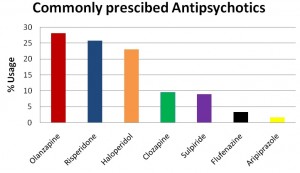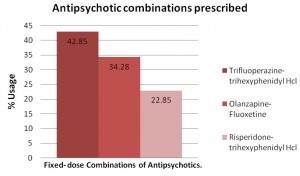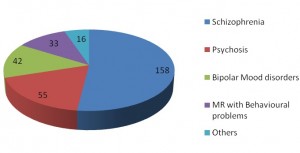DRUG PRESCRIBING PATTERN AND COST ANALYSIS OF ANTIPSYCHOTICS AT A TERTIARY CARE HOSPITAL
HTML Full TextDRUG PRESCRIBING PATTERN AND COST ANALYSIS OF ANTIPSYCHOTICS AT A TERTIARY CARE HOSPITAL
Sarjana Atal *1 and Shubham Atal 2
Department of Pharmacology 1, MIMS Medical College Kanadiya Gram, Indore, Madhya Pradesh, India.
Department of Pharmacology 2, Mahatma Gandhi Medical College, Madhya Pradesh, India.
ABSTRACT: Objective: Schizophrenia is a psychiatric disorders rapidly rising in India. There are numerous classes of antipsychotic agents available. It is important to find out which are the most frequently prescribed antipsychotics in population subsets of various regions of the country. Similarly, it is also important to do apharmacoeconomic evaluation of such treatment. Thus the primary objective of the study was to observe the prescribing pattern and evaluate the average cost of antipsychotics used. Methods: The drug prescribing pattern was noted from the Psychiatry OPD of Modern Institute of Medical Science, Indore and cost analysis performed for the drugs used. The data from OPD card of patients was obtained in a structured study proforma. Results: In 6 months, 304 cases reviewed out of which 158(52%) cases were of Schizophrenia. The Female to Male ratio of patients was 1.24. The average drugs per prescription were 3.17.68% of patients were on monotherapy. Out of total antipsychotics prescribed, 35.39% were Typical and 64.61% were Atypical Antipsychotics. Most commonly prescribed antipsychotic drugs were Olanzapine (28.08%), followed by Risperidone (25.84%) and Haloperidol (23.03%), among single agent antipsychotic drugs, while Trifluoperazine-trihexyphenidyl HCl (42.85%) was the most commonly prescribed fixed-dose combination. Average cost per prescription calculated was Rs.519.30. Medication cost (calculated for 30 days) was maximum for Aripiprazole (Rs 261.96) and cheapest for Olanzapine (Rs 111.12). Conclusion: Majority of Schizophrenic patients were treated with the atypical antipsychotic Olanzapine which is also the most cost effective drug.
| Key words: |
Pharmacoeconomics,
Cost-analysis, psychotropics, Schizophrenia antipsychotics, polypharmacy.
INTRODUCTION: The economic impact of Psychiatry illnesses is wide ranging, long lasting and huge. Schizophrenia is the commonest psychiatric illness seen among patients 1.These disorders impose economic burden on individuals, families and communities as a whole and have turned deflators pulling down the country’s GDP by at least 2-3% every year 1, 2.
Limited health care budgets and financial constraints lead to poor drug compliance and relapse which further perpetuates the economic burden 3. Hence, a new discipline of Pharmacology, “Pharmaco-economics” that makes the best use of limited resources by evaluating the clinical, economic and humanistic aspects of a pharmaceutical product has emerged 4. Pharmaco-economic evaluation provides health care decision makers, clinicians and patients with valuable information for optimal outcomes and the allocation of health care resources 5. Cost analysis study is a simple and effective partial pharmacoeconomic evaluation.
Antipsychotic medications have been available in India since a long time. Over the years the antipsychotic Pharmacopoeia has broadened and almost all the new anti-psychotics are available in India 6. However availability of new psychotropic agents and formulations with variable costs, as well as expanded indications for previously available agents, has had a profound impact on prescribing pattern in community psychiatry practice. Based on the side effect profile over the years, Atypical anti-psychotics have become the preferred choice and most of the recent guidelines also recommend the use of atypical agents as the 1st line of treatment of Schizophrenia 7. There are very few studies that have evaluated the antipsychotic prescription patterns from India. The data available has come from public sector hospitals and represents the prescription pattern specific to that center 6.
In this background the survey was undertaken to evaluate the drug prescribing pattern and cost analysis of antipsychotics at MIMS, Indore, a private medical college and hospital.
MATERIAL AND METHODS:
An Observational study was planned and conducted in the psychiatry department of Modern Institute of Medical Sciences, Indore. Approval from the Institutional Ethics Committee was taken for this study. In the study duration of 6 months between May to October 2015, a total of 304 patient prescriptions were included and relevant data collected. The data from the OPD card of the patients was noted on the Structured study Proforma. Cost (calculated for 30 days) of drug treatment was calculated as per the prices of drugs available in the standard commercial drug directory (CIMS – 2015 July - August issue)
- a) Evaluation of the prescribing pattern of antipsychotics:
The drug prescribing pattern of antipsychotics was evaluated by using the following parameters:
- Percentage of Typical and Atypical antipsychotics prescribed.
- Most commonly prescribed Typical and Atypical antipsychotics.
- Total no. of drugs / prescription.
- Percentage of Antipsychotic Polypharmacy defined as use of more than one antipsychotic agent per prescription.
- b) Pharmacoeconomic evaluation:
Cost analysis of antipsychotics was undertaken using the following indices:
- Average cost/ prescription
- Cost/ month of antipsychotics prescribed
RESULTS: Out of 304 cases reviewed, 158 (51.97%) cases were of Schizophrenia (Fig.1). Maximum patients (41.12%) were in between 15-30years. The number of males were 130 (42.9%) and females 174 (57%). 71.96% of the patients belonged to lower income group, interpreted according to the modified Kuppuswamy’s Socioeconomic Scale. The total number of Psychotropic drugs prescribed was 308 with average drugs per prescription 3.17 and average cost per prescription Rs. 519.30. Total number of antipsychotics prescribed was 178. Of these, typical antipsychotics prescribed were 63(35.39%) and atypical antipsychotics prescribed were 116(65.16%).
The most commonly prescribed antipsychotics were Olanzapine (28.6%) followed by Risperidone (25.84%) belonging to the class of Atypical antipsychotics and Haloperidol (23.03%) belonging to the class of Typical antipsychotics (Fig.2). Among the fixed-dose combinations, the combination of Trifluoperazine and Trihexyphenidyl HCl (42.85%) was most commonly prescribed (Fig. 3). Medication cost (calculated for 30days) was maximum for Aripiprazole (Rs 261.96) and cheapest for Olanzapine (Rs 111.12) as shown intable1.
Out of 304 patients followed, 68% of the patients were on antipyschoticmonotherapy. Other classes of psychotropic drugs prescribed commonly were anti-depressants (19.48%), mood-stabilizers (16.88 %) and anti-epileptics (5.84 %).
FIG. 1: CLINICAL CONDITIONS DIAGNOSED IN PATIENTS UNDER OBSERVATION.

FIG.2: USAGE (%) OF COMMONLY PRESCRIBED INDIVIDUAL ANTIPSYCHOTICS.

FIG.3: USAGE (%) OF ANTIPSYCHOTICS IN FIXED-DOSE COMBINATIONS WITH OTHER DRUG GROUPS
TABLE 1: COST OF DIFFERENT CLASSES OF ANTIPSYCHOTIC MEDICATIONS PRESCRIBED.
| Drugs | Dosage form | Average daily dose (mg) | Average Cost/month |
| Haloperidol | Oral | 8.75 | 63.6 |
| Fluphenazine | Injection | 0.83 | 30.9 |
| Sulpiride | Oral | 75 | 368.25 |
| Olanzapine
Risperidone |
Oral
Oral |
7.6
3.5 |
111.12
191.7 |
| Clozapine | Oral | 108 | 133 |
| Aripiprazole | Oral | 16.6 | 261.96 |
| Risperidone-trihexyphenidylHcl | Oral | 7.6 | 116.7 |
| Trifluoperazine-trihexyphenidylHcl | Oral | 10.03 | 44.7 |
| Olanzapine – Fluoxetine | Oral | 27.5 | 186 |
DISCUSSION: The results of this study showed that 52% cases were of Schizophrenia within age group of 15-30 years which is in line with the Schizophrenia facts and statistics by International Mental Research Organization 8. The average number of psychotropic drugs/prescription is this study was 3.17 which were similar to that reported by Mukherjee et al (3.39) 9 but was higher than that found in other studies where it ranged from 1.79 to 3 drugs per prescription 10, 11. Average number of drugs in a prescription audit is an important factor because higher number increases the risk of side effects and interactions. Average Medication cost/prescription was Rs 519.30, which includes other medicines like anticholinergics, antidepressants, mood-stabilizers or palliative medicines. The average medication was higher than the cost stipulated by P.Sharma et al as Rs 35312. Indirect costs (time loss, travel costs etc) were not taken into considerations.
This survey also reflects that use of Typical antipsychotics (35.39%) is waning as compared to Atypical antipsychotics (65.16%) which reflects the observation made in studies done by Ramdas et al 13 and Grover et al 14 wherein it has been observed that very few patients are prescribed Typical antipsychotics.
Olanzapine (28.08%) was identified as most commonly prescribed atypical antipsychotic followed by Risperidone (25.8%) which is in line with recent studies of Trivediet al 15 and Grover et al 14 who reported that Olanzapine and Risperidone are the most commonly prescribed drugs.
Olanzapine (Rs 111.12) was found to be the cheapest and effective atypical antipsychotic which is in concurrence with a study done in New Zealand by Foster et al 16 who showed that the total direct cost were significantly lower with Olanzapine than with Haloperidol and Risperidone. 32% of the patients were prescribed more two or more than antipsychotic medications which has been defined as polypharmacy17. This figure is less than that found in the actual survey of prescriptions done in the East Asian countries with 48% of polypharmacy, out of which Japan being the highest (79%) 18. However, polypharmacy observed in our study is more than that reported by Padmini
Devi et al which reported about 9% of antipsychotic polypharmacy in the psychiatry OPD of St Johns Medical College, Bangalore, while lower than that observed by Sawhney et al (72.72%) at one end of the country (Jammu) 19. The possible explanation of high prevalence of polypharmacy in our set up may be 1) When a patient is showing inadequate response, a physician may add a medication to what is currently prescribed; when the patient shows some improvement the physician is reluctant to change this regime 19. 2) When changing medications, a physician noting an improvement while a new medication is being decreased may stop the cross-titration and continue co-prescribing both antipsychotic medications 19. 3) Pressures from hospital administrations in reducing hospital stays of Inpatients may increase pressure on polypharmacy. 4) Doctors with multiple hospital attachments may be more inclined to prescribe multiple drug prescriptions 20, 21.
CONCLUSION: Changing economic trends have meant that evaluation of treatment costs is no longer a subject of mere academic interest, even in the developing world. In this changed current scenario, there is an urgent need for more Indian studies evaluating the prescription patterns and economic burden of the commonly prescribed antipsychotics. The present study will thus provide lead for further studies in this field.
ACKNOWLEDGMENTS: None.
CONFLICT OF INTEREST: None.
REFERENCES:
- World Health Organization. Burden of Mental and Behavioural Disorders. Mental Health Report: New Understanding, New Hope. The World Health Report , 2001;13-26
- Akhileshwar S. Economic costs of mental illness. Economic Times. Indiatimes.com June 2010
- Khubchandani V, Hishikar R, Agrawal M et al. Pharmacoeconomics of Schizophrenia. A comparison of Allopathy and Alternate therapy. International Journal of Advanced Research 2015; 3(8): 1160-68.
- Berger ML, Bingefors K, Hedblom EC, et al. Health Care Cost, Quality and Outcomes: ISPOR Book of Terms.2nd Lawrenceville, NJ:ISPOR,2003
- Haghparast-Bidgoli H, Kiadaliri A and Skordis-Worrall J. Do economic evaluation studies inform effective healthcare resource allocation in Iran? A critical review of the literature. Cost Effectiveness and Resource Allocation 2014; 12:15.
- Rode S, Salankar H, Verma P et al. Pharmacoepidemiological survey of schizophrenia in Central India. International Journal of Research in Medical Sciences 2014; 2(3): 1058-62.
- Gupta M, Moily NS, Kaur H et al. Identifying a predictive model for response to atypical antipsychotic monotherapy treatment in south Indian schizophrenia patients. Genomics 2013; 102(2): 131-5.
- Schizophrenia Facts and Statistics; Schizophrenia.com. International Mental Health Research Organization.www.imhro.org.
- Mukherjee S, Sen S, Chatterjee S et al. Prescribing pattern of Psychotropic medications in Psychiatry outpatients at a tertiary care teaching hospital in India: A prospective Cross-sectional study. International Journal of Hospital Research 2014; 3(3):113-22.
- Lahon K, Shetty H, Paramel A, et al. A retrospective drug utilization study of antidepressants in the psychiatric unit of a tertiary care hospital. J Clinical Diagnostic Research 2011, 5(5):1069-75.
- Al Khaja KA, Al-Haddad MK, Sequeira RP, et al. Antipsychotic and anticholinergic drug prescribing pattern in psychiatry: extent of evidence-based practice in Bahrain. Pharmacol Pharm 2012, 3(4):409-16.
- Sharma P, Das SK, Deshpande SN. An estimate of the monthly cost of 2 major mental disorders in an Indian Metropolis. Indian Journal of Psychiatry Jul-Sep 2006;43(3);143-48
- Ramadas S, Kuttichira P, Sumesh TP, et al. A study of an Antipsychotic Prescription pattern of patients with Schizophrenia in a Developing Country. Indian Journal of Psychol Medicine Jan-June 2010; 32(1):13-16
- Grover S, Kumar V, Avasthi A et al. An audit of first prescription of new patients attending a psychiatry walk-in clinic in north India. Indian Journal of Pharmacology 2012; 44(3): 319-25.
- Trivedi JK, Dhyani M, Yadav VS, et al. Anti-psychotic drug prescription pattern for Schizophrenia: Observation from a general hospital psychiatry unit. Indian J Psychiatry Jul-Sep.2010;52(3):279
- Foster RH and Goa KL. Olanzapine. A pharmacoeconomic review of its use in Schizophrenia. Pharmacoeconomics Jun 1999;15(6):611-40
- Shrivastava A, Johnston M, Terpstra K et al. Atypical antipsychotics usage in long-term follow-up of first episode schizophrenia. Indian Journal of Psychiatry 2012; 54(3):248-52.
- Chong MY, Tan CH, Fujii S, et al. Antipsychotic drug prescription for Schizophrenia in East Asia: Rationale for change. Psychiatry and Clinical Neurosciences July 2004; 58:61-67.
- Kukreja S, Gurvinder K, Shah N et al. Polypharmacy in Psychiatry: A Review. Mens Sana Monographs 2013; 11(1):82-99.
- Kingsbury SJ, Yi D, Simpson GM. Rational and Irrational polypharmacy. Psychiatry Services Aug. 2001; 52(8):1033-36.
- Bjerrum L, Soggard J, Hallas J, et al. Polypharmacy in general practice: Differences between practitioners. British Journal of General Practice March 1999; 49:195-
How to cite this article:
Atal S and Atal S: Drug Prescribing Pattern and Cost Analysis of Antipsychotics at a Tertiary Care Hospital. Int J Pharm Sci Res 2016; 7(6): 2611-14.doi: 10.13040/IJPSR.0975-8232.7(6).2611-14.
All © 2013 are reserved by International Journal of Pharmaceutical Sciences and Research. This Journal licensed under a Creative Commons Attribution-NonCommercial-ShareAlike 3.0 Unported License.
Article Information
42
2611-14
356
1709
English
IJPSR
Sarjana Atal * and Shubham Atal
Department of Pharmacology, MIMS Medical College Kanadiya Gram, Indore, MP, India
sarjanamantri@gmail.com
20 January, 2016
29 February, 2016
17 March, 2016
10.13040/IJPSR.0975-8232.7(6).2611-14
01 June 2016


